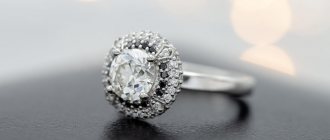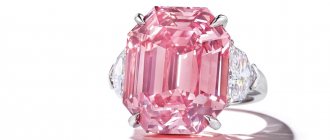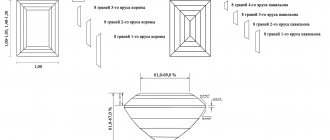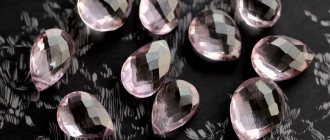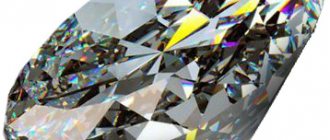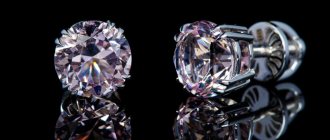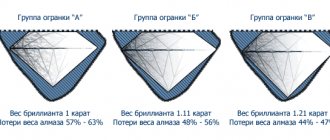Cutting history
The history of gem cutting goes back centuries.
Until the 20th century, all diamonds were cut by hand. At the same time, the symmetry of the edges was not observed, because the main goal was to preserve as much raw material as possible. Therefore, each finished sample was unique. Jewelers of that time did not calculate or maintain the angles of inclination of facets relative to each other, determining them by eye. For this reason, the performance of antique diamonds is much weaker than that of modern ones. History of cutting: jewelry techniques of the 16th–17th centuries.
In the 16th century, Europeans began to use directional splitting of crystals as one of the cutting methods, using a thin steel blade and a special hammer. This method was mentioned in his work “Gems and History” (1609) by the Flemish mineralogist Anselmus de Boudt.
Perhaps the technique was known earlier in India. This theory can be confirmed by the notes of the French merchant Jean-Baptiste Tavernier, who was active in the diamond trade with India. He wrote that Indians were more skilled in splitting precious stones than Europeans.
Other cutting techniques of the 16th century are described by the Italian sculptor and jeweler Benvenuto Cellini in his work On Jewelry and Sculpture. The treatise contains information that in order for a diamond to receive a platform, facets and apex, it is secured in a holder, which fixes the stone for processing on a rotating wheel made of hardened steel. The wheel, in turn, is attached to a hand mill and allows you to cut and at the same time polish from 4 to 6 diamonds at the same time using diamond dust.
Later, a new method appeared in the arsenal of cutters - sawing diamonds. The technology was described in 1647 and was used until the 19th century. It involved the use of a thin thread with a mixture of diamond dust and oil applied to it, with the help of this thread sawing was carried out.
One of the oldest cut varieties is “Rose”.
Appearing in the 16th century, it was popular until the 18th century. It was replaced by the “Old Cut”, or Old mine. This is one of the very first varieties of diamond cuts. Cutting in the 19th century
In the first half of the 19th century, cutting centers developed rapidly in Antwerp, London and Amsterdam. Changes in the industry reached their climax by mid-century with the invention of the first steam-powered diamond cutting machine by Henry Morse and Charles Field (patented 1874). The device made it possible to obtain symmetrical round stones.
In 1892, Daniel Swarovski invented the first electric cutting machine, which marked the beginning of the commercial use of round diamonds.
In 1900, the circular saw was introduced, allowing less precious raw materials to be wasted. It was used to separate crystals that could not be split. With new technologies came golden days for the cutting industry.
17th century cutting
At the beginning of the 17th century, in diamond mines in Brazil, gems were cut in such a way that the girdle took the shape of a pillow. The corners of the processed diamond were rounded, the stone looked larger. Shaft or cushion processing preserved the diamond from chipping at the corners. The previous table cut looked boring and was impractical. After the discovery of diamond deposits in South Africa, this type of diamond finishing became known as “old mine cutting.” As a result of grinding, the original weight of the nugget is preserved as much as possible. An improved form of the shaft cut is the cushion type with 57 facets: 33 in the crown and 24 in the pavilion.
Stone processing
A diamond is a diamond only after cutting, only then is it used in jewelry. Whatever its grade, this precious stone makes any piece of jewelry exquisite and desirable.
Technically, diamond processing is not difficult, but physically expensive. Almost all mineral processing operations have been carried out manually for centuries; only the shapes and types of stone cutting have been improved.
Mineral processing requires special skills, patience and leisurely decision-making. The future shape of the crystal and the type of cut depends on its natural shape, number of carats, the presence of flaws and various types of inclusions. A cutter is constantly forced to choose between the size and weight of a multi-carat stone or its ideal quality. One way or another, whatever the master chooses, the cut of the diamond must be of the highest quality.
Basic Concepts
As in any business, in jewelry there are professional terms that denote elements and processes. Terms help craftsmen understand each other and production technology in general.
- The girdle is the widest place in the cross-section of the sample; the frame in the product is attached to it;
- The crown is the visible part of the mineral, the most spectacular; the crown has edges and wedges;
- Pavilion – the lower part of the sample, located under the dividing line of the girdle;
- Calleta – the lowest point of the crystal, hidden in the frame;
- The platform is a wide flat edge located at the top in the horizontal plane.
Facet, step or diamond cutting helps to reveal the beauty of translucent minerals. On its basis, gems are given any shape - antique ball, trapezoid and others.
Old European Cut vs Modern Round Cut Brilliant
The old European cut and the modern round brilliant cut have some common features that make them similar. For example, both are round in shape and have 58 edges. However, the two cuts have noticeable differences that help differentiate them: Table Size: OEC diamonds have a smaller table compared to round diamonds. This is especially noticeable when comparing stones of the same size. Crown Height: OEC diamonds have a higher crown compared to round diamonds of the same carat weight. Pavilion Depth: OEC diamonds typically have a higher crown height, which means they have a deeper pavilion than similarly sized round brilliant cut diamonds. The Old European Cut and the Modern Round Brilliant Cut share some common features that make them similar . For example, both are round in shape and have 58 edges.
Types of cutting of jewelry stones.
Circle
This type of cutting of jewelry inserts appeared at the beginning of the 20th century. It was created using the very first tools of master cutters. The magnificence of this cut stone is revealed through its 57 perfect facets. For small crystals, 17-33 faces are sufficient.
Oval
In the second half of the 20th century, the Oval cut began to be used. Wedge-shaped facets, 57 in number, make the stones sparkle and shimmer under the sun's rays.
Marquise
The Marquise cut has an elongated oval shape with sharp ends. She was named in honor of the Marquise de Pompadour. The second name for this cut is navette (shuttle). Masters form 55 faces on the crystal.
Princess
The Princess cut was originally used for engagement rings. A large stone with 68 sides was placed in the center and surrounded by smaller stones with 49 or 65 sides.
Emerald
The Emerald cut is of interest due to its unusual nature. This is a stepwise processing method that is used for large translucent stones. Its peculiarity is the beveled corners, from which glare of light is reflected.
Pear
The Pear cut is similar to the Marquise cut. The difference is in the number of faces (there are 55 of them) and one end tapers, making the crystal look like a drop. The pointed part is inserted into the frame.
Heart
This cut option is one of the most expensive. Special faceted tools are used. Adhering to 1:1 proportions of length and width, craftsmen make the stone perfectly durable and beautiful.
Baguette
These are types of cut gemstones that are similar in appearance to Emerald. The difference is the smaller number of edges. Used for processing small stones. Emerald emphasizes even the smallest cracks in the stone.
Square
The name comes from the Latin word “exquadra”, i.e. square cut stone. Square-shaped crystals look original due to their equal sides and “step” cut. The edges are applied in stages and parallel to the edges, forming a pyramid with a cut off top.
Cabochon
Cabochon stone cut is a stone with a flat base and a semicircle without edges. It is of French origin - “caboche” (head). Can be oval, round or pear-shaped.
Trillion
Dutch masters in the 20th century invented the Trillion, which became the most common cut. It is made in the form of an isosceles triangle. The number of faces depends on the crystal itself - its shape, color and density.
Asher
A cut similar to Emerald, but with more levels. Craftsmen independently select the shape of the edges. Their number varies from 25 to 72. If the stone is very large, the number of sides also increases.
Octagon
Pure minerals of bright colors are processed using the Octagon type. The result is octagonal rectangles protected from mechanical damage.
Cushion
This cut has four rounded corners and convex sides. Resembles the shape of a pillow.
Cushion was invented a long time ago. It gained particular popularity in the Baroque era.
Briolette
The Briolette cut appeared at the beginning of the 17th century and was popular until the mid-Victorian era. This cut involves creating a pendant. Many diamond-shaped faces sparkle mesmerizingly in the light of candelabra and candles, but look boring in modern lighting. Today Briolette is considered a vintage cut.
Having become familiar with the main types of cutting of jewelry inserts and crystals, you can look at jewelry with jewelry stones in a new way. It will become easier to navigate when choosing materials for your own products. Remember, in any business the main thing is inspiration.
Preciosa stones
Preciosa
Preciosa
